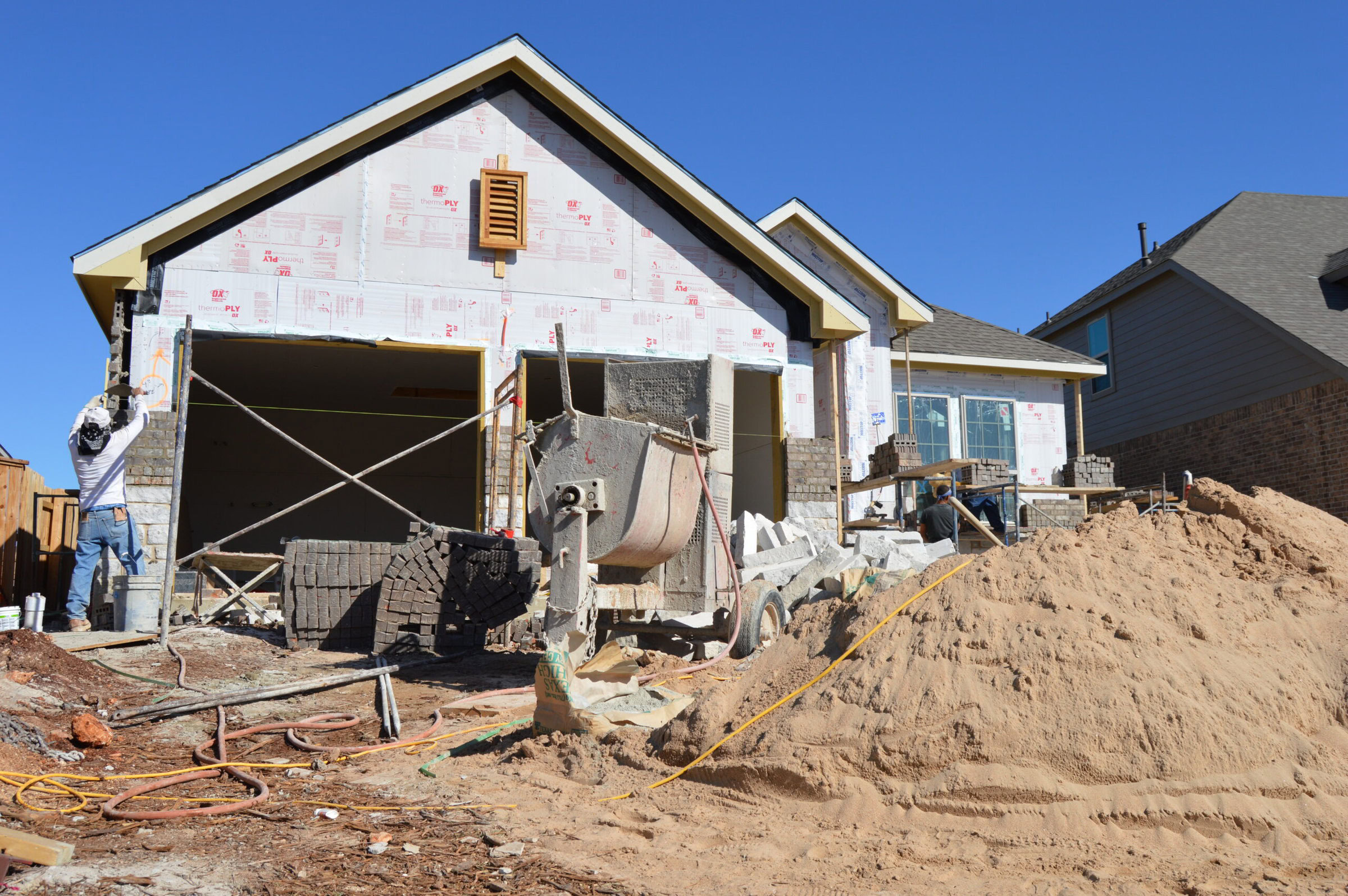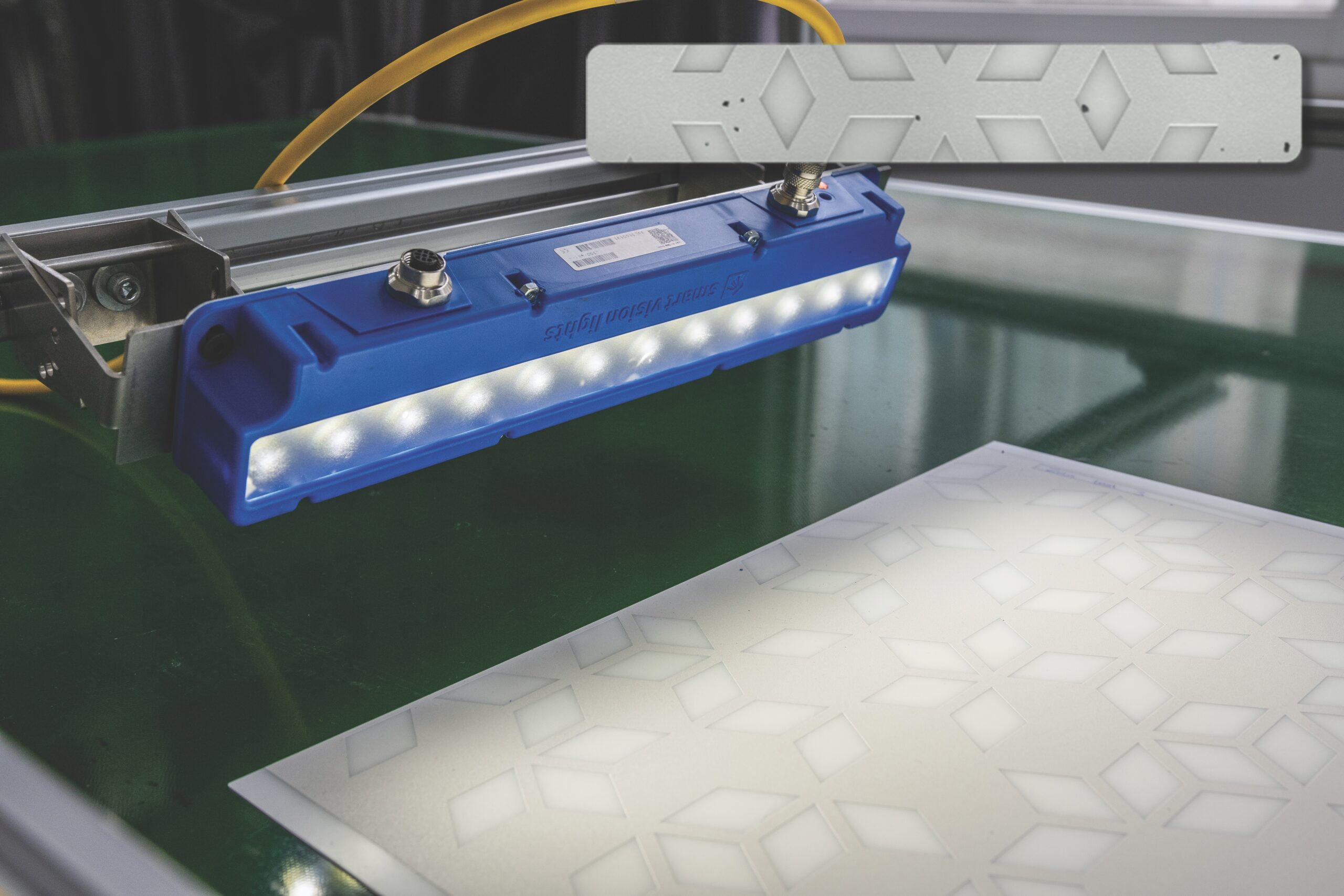Across the globe, 230 billion m2 in new construction is expected to be built over the next 40 years. For scale, that unprecedented rate is the equivalent of building Paris every week for the next four decades.1
In part, this is because of growing global population—approaching eight billion people—each of whom needs a place to live. Urban areas are growing at a rate of 200,000 people per day,2 causing many cities to feel the pressure under struggling infrastructures, skyrocketing housing prices, and rising homelessness.
So it is no surprise that residential housing represents a size-able portion of the globe’s total future construction. The global market for residential building construction, including new builds, renovation, and remodeling, was worth nearly $4.17 trillion in 2017 and is predicted to reach nearly $6.80 trillion by 2022, growing at a healthy compound annual growth rate (CAGR) of 10.3%. The Asia Pacific region, driven by growth in China, constitutes 58.1% of that market, followed by North America (19.4%) and western Europe (11.5%).3
Construction has a significant impact on global economies as well. The residential building construction market comprised an estimated 5.8% of global gross domestic product (GDP) in 2019 and is expected to reach 6.9% by 2022. Also considering both residential investment and consumption spent on housing services, which includes things like rent and utilities, housing contributes an average 15–18% GDP.4
“At the national level, the impact is broad-based, as jobs are generated in the industries that produce lumber, concrete, lighting fixtures, heating equipment, and other products that go into a home or remodeling project,” according to the National Association of Home Builders report.5 “Other jobs are generated in the process of transporting, storing, and selling these projects. Still others are generated for professionals such as architects, engineers, real estate agents, lawyers, and accountants who provide services to home builders, home buyers, and remodelers.”
In total, construction of each new single-family home in the U.S. contributes an estimated 2.97 jobs to the economy and $280,433 in combined wages and profits.6 In other words, the construction industry is large, it is significant, and its impact extends wide.
Energy efficiency
In addition to having a significant impact on global economies and markets, buildings and construction together account for about a third of global energy use and energy-related CO2 emissions—making construction a prime target for efforts to reduce energy consumption.
“If there’s a defining theme for the building sector in 2019, it’s energy codes,” according to a New Buildings Institute article.7 “Actions to update the rules that cities and states set to determine how effectively new residential and commercial buildings use energy are progressing on several fronts across the U.S.”
Regulations and initiatives nudge toward increased energy efficiency across the globe, nudging companies and industries to act to reduce their use of energy, water, and resources as well as their total negative impact on the environment.
In the U.S., a national model for energy use standards called the International Energy Conservation Code (IECC) forms a precedent for more local adoption of energy-use standards by U.S. states and cities. Updated every three years, IECC codes target building envelopes as well as mechanical, lighting, and power systems for opportunities to increase energy efficiency.
In Europe, the European Energy Performance in Buildings Directive mandates that all new buildings achieve nearly zero-energy status by 2020—meaning that the buildings must use low amounts of energy sourced mostly from renewables.
Materials offer solutions
Considering that the construction industry uses over 400 million tons of material every year,8 materials provide vast potential to improve building energy efficiency.
For instance, producing an annual estimated 76 million tons of finished concrete for U.S. construction generates 9.8 million tons of CO2.8 However, efforts to reduce concrete use can only go so far, so changes to reduce the negative environmental impact of producing and using concrete become important for future sustainability.
Advancements in the materials themselves as well as improvements to their production, use, and disposal are all important considerations to reduce overall energy use and mitigate negative environmental impacts.
Advanced materials offer broad advantages, such as increased recyclability, reduced construction time, and higher quality, versatility, and durability and are already changing residential construction, according to a BCC market report.3
“Fluor, a U.S.-based construction company, is using 50%-faster-curing concrete in its construction projects. Other advanced construction materials in the market include super-lightweight ceramic sidings, organically coated steel, self-healing concrete, rain-absorbing roof-mats, and micro-encapsulated phase-change material.”
In other words, materials offer solutions.
These solutions represent substantial industries for diverse building products, which, due to the size and scope of the construction industry, significantly influence supply chains, R&D, and manufacturing of the even more diverse materials they incorporate.
“The European Commission estimates that 70% of product innovation across all industries is derived from new or improved materials,” according to a World Economic Forum report on the future of construction.2 “With approximately one-third of construction cost attributed to building materials, the scope for applying advanced building materials is considerable.”
Enabled by ceramics and glass
In the U.S., the median size of a new single-family home sold in 2018 was 2,435 ft2 (median price: $281,200).9 However, that size varies significantly across the developed world, with an average for all homes closer to 1,200 ft2.10 The variation gets even wider if you consider all the dwellings called home across the entire globe.
Each of those dwellings contain a host of materials, which themselves vary widely based on the region, climate, availability, preference, and local practice.
What most people call home, however, includes ceramic and glass materials on the interior and exterior surfaces, within walls and spaces, and affixed throughout—top and bottom, inside and out. Ceramic and glass materials are integral to both building homes and making homes functional buildings to inhabit.
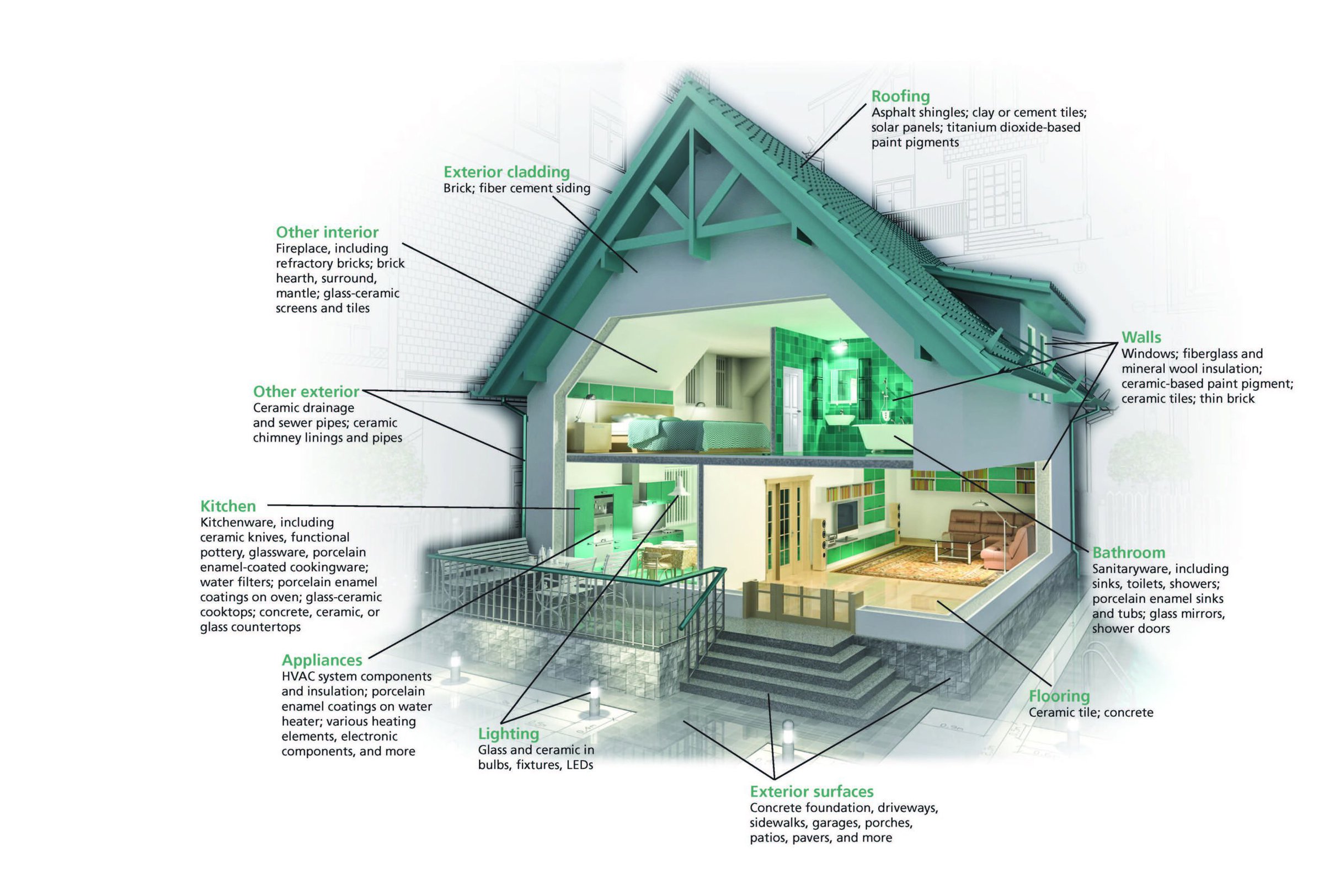
Figure 1. Ceramic and glass materials contribute function and beauty in every room and system in a home. Credit: iStock.com/nikonaft. Text overlay by ACerS.
This article provides a snapshot into use of ceramics and glass in and around a home and the markets they drive. While the full extent of these applications is beyond the scope of this article, Figure 1 shows some examples of specific applications and places where ceramic and glass materials can be found in residential homes.
Further, the materials and the products they enable represent significant industries that contribute to the global economy. Table 1 provides a sampling of companies that manufacture ceramic and glass materials or products tied to the construction industry and a glimpse of the commerce involved.

Materials make the home
Raise the roof
Globally, roofing sales are expected to hit $120 billion by 2022, with bituminous products, the category that includes asphalt shingles, the most popular choice for roofing in 2017 with 34% of global sales. Concrete and clay tiles accounted for 30% of the market in terms of area of roofing, although they account for the largest fraction of sales due to the products’ higher price. The rest of the roofing market divides between metal (11%), fiber cement (6%), rubber (4%), and plastic materials (5%) (“other” materials account for the remaining 10%). Demand for all types of roofing globally is expected to rise 2.4% annually through 2022.11
It is no surprise that the roofing market itself is heavily influenced by weather. Weather-related reroofing alone accounts for about a third of U.S. demand for residential roofing per year.12
“With storms becoming more powerful and more frequent, roofing must boast increased durability and impact resistance,” says Lucas J. Hamilton, manager of applied building science for Saint-Gobain Corp. (Malvern, Pa.).
Storm-resistant roofing is predicted to account for a growing portion of the market, especially as insurers require installation of these products as a term of coverage and building codes increasingly demand them. These include wind-resistant, impact-resistant, and UV-resistant products, as well as those that withstand extreme temperatures or prolonged moisture.12
Modern laminated asphalt shingles have been engineered to withstand wind gusts of up to 140 mph, have impact resistance to intense hail and windborne debris, or better reflect solar radiation to improve homes’ energy efficiency. These properties are significant developments from the first iterations of asphalt shingles, which were often composed of organic matter such as cotton rags, paper, and wood pulp, coated with asphalt, and topped with crushed slate, oyster shells, or other rock-like materials.
“In the 1970s, there was a big transformation in the industry to use fiberglass mat to serve as the backbone or the structure of shingles,” says Carmen LaTorre, senior R&D leader for shingle innovation at Owens Corning. Fiberglass mats themselves not only provide modern asphalt shingles with much more durability, but they have also allowed shingles to get thinner and lighter, allowing multilayer designs that further improve strength and durability.
The other major improvement in modern shingles, LaTorre says, is that modern asphalt shingles are topped with engineered ceramic-coated granules instead of crushed rocks. The ceramic coatings can contain different additives, ingredients, and pigments to achieve various performance functions or desired colors. Granules can even receive multiple coatings, each applied as a slurry and kiln-fired onto the granules, to achieve a desired combination of performance or processing benefits. For example, by mixing together granules with different pigments and shades of pigments, manufacturers can fabricate shingles with rich dimensional effects that mimic other types of roofs but have the enhanced performance of asphalt shingles (Figure 2).
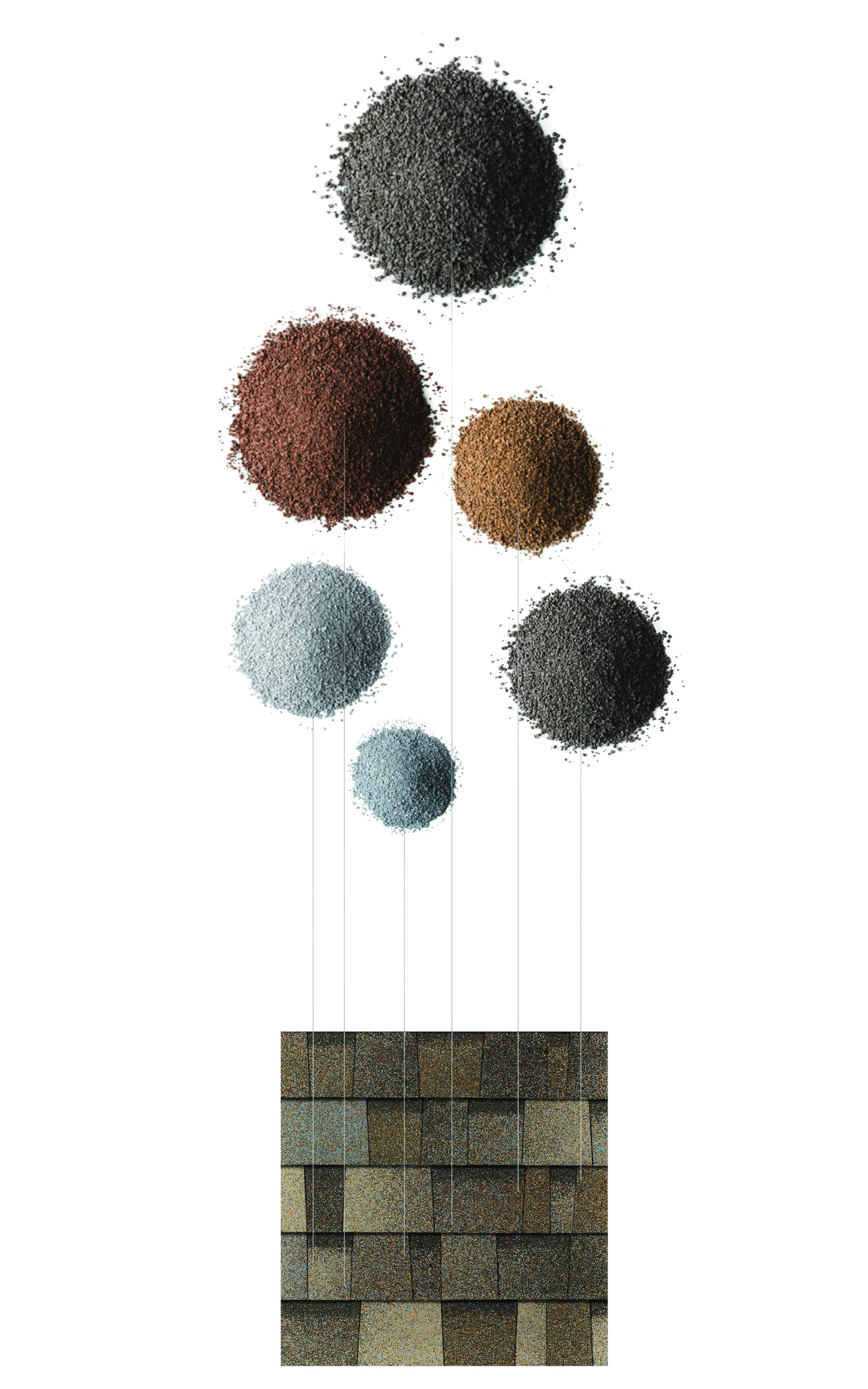
Figure 2. Ceramic-coated granules can be manufactured in an array of colors and functionalities to provide dimensional effects and performance to asphalt shingles. Credit: Owens Corning
Pigmented ceramic-coated granules are not just for looks, however—they also can be designed with specific functional features, such as better light reflectivity. Roofs that better reflect the sun’s radiation, commonly called “cool roofs,” help buildings reduce energy use by preventing radiation from being absorbed into buildings as heat. Whereas standard asphalt roofs reflect less than 20% of sunlight, cool roofs reflect an average 67% of direct sunlight.13
In the U.S., regulations in California have been particularly influential in driving demand for roofing materials with enhanced reflectivity to increase the energy efficiency of buildings and reduce urban heat island effects. The state’s CalGreen standards—the first statewide set of mandatory green building codes in the U.S.—specify that buildings must adhere to various practices spanning planning and design, energy efficiency, water conservation, material conservation and resource efficiency, and environmental quality.
For roofing materials in particular, CalGreen codes include standards for solar reflectance index, which measures a material’s ability to reflect solar heat.
“Roofing is being influenced by energy efficiency requirements, and the industry must meet these requirements by being nimble and efficient despite the ongoing labor shortage,” Hamilton says.
While California’s regulations drive development of cool roofs, industry is watching this market segment and technology closely. “The industry is monitoring this and coming up with higher reflective coatings or granules” LaTorre says. “Even today, discussion continues around what those standards are and whether they will be even more stringent in the future.”
If codes do become more stringent, roofing materials will undoubtedly evolve alongside. But designing and testing new roofing materials is a difficult task, partly because the existing materials today already have such high performance.
“For any new material, you must have a really rigorous protocol to show that it can withstand the cold, the hot, the cycling temperatures,” LaTorre says. “So that’s one of the biggest challenges to product developers—you’ve got a great track record with existing materials, so how do you make sure that you evaluate that the next generation of materials can have that same durability?”
Better with brick
For thousands of years, human civilizations have inhabited brick structures—many of which, impressively, still stand today.
While the clay-based materials in brick changed relatively little across thousands of years, the manufacturing processes shifted dramatically.
“On the operations side, there’s been a lot of innovations to try to make product as efficiently and cost effectively as possible,” says Stephen Sears, chief operating officer and vice president of marketing for the Brick Industry Association (Reston, Va.).
In addition to automation, modern brickmaking plants also adopted extensive innovations in the kilns and dryers—including variable speed drives to electronically control fan speed and pulsed firing technology to improve firing efficiency—that significantly improved the industry’s energy efficiency. “These methods have really enhanced the industry’s fuel efficiency per unit of production,” according to Garth Tayler, an expert with more than 50 years of experience in the brick industry and retired technical director for Acme Brick (Fort Worth, Texas).
The U.S. clay brick and product manufacturing industry—which includes clay brick, ceramic tiles, and refractory products—is estimated to reach $7 billion in total revenue in 2019, representing an annual 2.3% growth from 2014–2019.14
Despite this incremental growth, the brick industry is still recovering from the 2008–2009 Great Recession. “Our total manufacturing net sales, what’s called value product shipments, was about $1.2 billion total in 2018. We were up to $2.2 billion at some point in the 2000s but we got hit really hard in 2011,” Sears adds.
And although he says the brick industry recovered from that trough, it is still not yet back up to pre-recession levels.
Part of that is due to the reduced number of new homes starts since the Great Recession hit its hardest. While numbers have been steadily increasing year over year, the number of new single-family homes built in the U.S. in 2018 was nearly 50% of that in 2005 (Figure 3). That change of pace was felt across the construction industry.
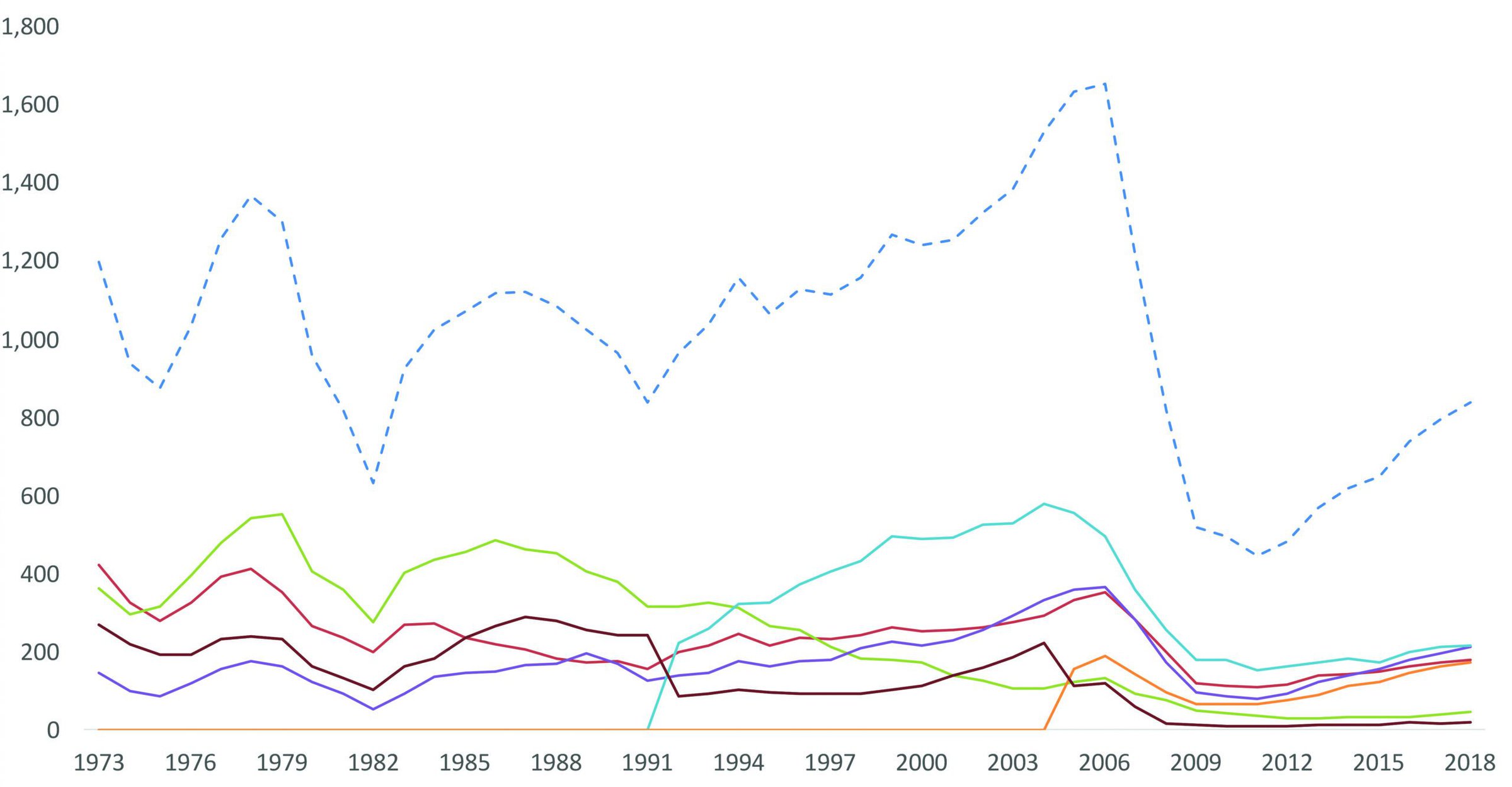
Figure 3. U.S. Census Bureau data showing total new single-family houses (dotted line) and houses by primary type of exterior wall material completed in the U.S., 1973–2018. Credit: ACerS
In 2018, 21% of new single-family homes had exteriors clad in brick, a percentage that remained relatively stable in the U.S. over the past several decades.15
Today, homeowners and builders have more choices than ever for exterior cladding, and that is one of the biggest current challenges for brick. “We are under incredible competition,” Sears says. “And there are some really strong competitors.”
Perhaps the strongest competition comes from fiber cement siding, a durable composite siding product composed of cement reinforced with cellulose fibers, often wood pulp. Fiber cement represents the fastest growing exterior material category, expected to increase 3.6% annually through 2022.16 While fiber cement clad the exterior of just 9% of new single-family homes in the U.S. in 2005, that share jumped to 20% in 2018—just behind brick’s 21%.15
While other cladding materials offer lower cost than brick, none comes close to its strength and durability.
“Brick is by far the most durable and requires the least amount of maintenance,” says John Hewitt, assistant plant manager of Interstate Brick (West Jordan, Utah). After considering the cost of maintenance and replacement, which can become significant with other materials, he says, brick comes out on top.
Research at the National Brick Research Center (NBRC; Anderson, S.C.) measures and quantifies brick properties, which demonstrate that brick as a cladding material is unsurpassed in terms of thermal performance and impact resistance.
“The way energy codes work right now, is all based on R-value,” says John Sanders, director of NBRC and research associate professor of materials science and engineering at Clemson University. “It’s an artificial sort of temperature measurement that doesn’t simulate the real world. And it completely neglects materials like brick that have a significant amount of thermal mass.”
The R-value reflects the ability of a material or system to resist heat transfer through conduction. A higher R-value indicates greater insulating ability because the material or system prevents more heat transfer.
To more accurately test and demonstrate the real-world performance of brick walls, NBRC specially built hot boxes to quantify the thermal performance of entire 6-foot by 8-foot wall panels. “When we subject brick wall panels to real-world temperature cycles, what we find is that energy use is up to 50% less that what R-value would tell you,” Sanders explains.
Based on these results, Sanders says brick likely performs even better than its R-value indicates. However, current codes do not reflect these new data because the codes are based on the assumption that convection is the major contributor to heat flow for brick walls. “What we’ve been able to prove is that it’s actually radiation in that air space that is the dominant means of air flow, and convection is a very minor contributor,” he adds.
Using these kinds of data, NBRC is researching how to further improve the performance of brick wall systems, such as incorporating radiant barriers in the wall and optimizing the size and coring of brick.
A recent innovation in the brick industry is thin brick. Thin brick, just 0.5–1.5-inch thick instead of the typical 3-5/8-inch thickness of standard brick, offers versatility. In addition to both interior and exterior applications, it can go places where a full brick is space or weight prohibitive. Installation is faster and easier, and thin brick can be added in renovations and installed on accent walls and backsplashes, for example.
Demand for thin brick is high, and companies are certainly investing in them. Whereas many companies simply manufacture standard brick and saw the faces off to fabricate thin bricks, Interstate Brick recently invested in a separate extrusion line specifically designed to fabricate thin brick, Hewitt says. “In general, the industry is currently faced with the challenge of how to make enough of these without additional manufacturing steps, particularly saw cutting full-sized brick down into thin-brick slices.”
Insulation keeps us comfortable
Each year, cities around the globe continue to set new records for hottest and coldest days on record. These temperature extremes and increasing urbanization are expected to drive growth in sales of new and upgraded heating and air conditioning systems, especially in Europe. The number of European households that buy and install a new air conditioning system is expected to increase by an average of 4.3% per year through 2040.17
Ceramic components can be found in both forced-air furnaces, the most common system in the U.S. (58% of heating systems in newly completed single-family houses in 2018), and heat pumps (40% of heating systems), which act as both furnace and air conditioner.15 For instance, modern gas furnaces commonly contain a silicon carbide or silicon nitride hot surface ignitor.
The U.S. Department of Energy estimates that about half of a home’s energy use is spent heating and cooling spaces, while 18% is spent heating water, indicating these systems and proper insulation of these systems have a significant role to play in residential energy savings.18
In fact, modeling studies show that electricity consumption could have been reduced by 37 terawatt-hours per year in the U.S. just by increasing insulation to 2012 IECC levels in all existing single-family homes in 2013, representing a total 3.4% reduction in annual electricity consumption.19
Demand for insulation of all types is predicted to rise in the U.S. through 2021, influenced by increasing demand for energy efficiency and by states increasingly adopting IECC mandates.20
Although there are various types of insulation materials, fibrous mineral insulation, which includes fiberglass and mineral wool, represents the largest portion of the U.S. insulation industry. This is a significant industry—insulation manufacturing is a $13.9 billion industry in the U.S. and generates more than 500,000 total jobs, including manufacture, distribution, and installation of insulation.18
In residential homes, insulation is most common in the exterior walls and the attic or roof area, where most heat escapes. Home Innovation’s 2019 Annual Builder Practices Survey of home builders indicates that fiberglass insulation (batt and blown) comprises 71% of insulation in new single-family homes built in 2018 (including floors, walls, and roofs).21 Fiberglass insulation consists of loosely bonded thin glass fibers separated by pockets of air.
“The focus of manufacturing for insulation materials continues to be driven by efforts to lower environmental impacts and decrease embodied energy,” says Saint-Gobain’s Lucas Hamilton.
One way for insulation manufacturers to lower their environmental impact is by using recycled content. Most fiberglass manufacturers in the U.S. spin glass fibers from 40%–60% recycled glass content,22 which both diverts a material waste stream from landfills and offers additional energy savings during insulation manufacturing.
Including recycled glass in the melt reduces the energy requirements to manufacture fiberglass. “From a manufacturing standpoint, it’s easier to melt already formed glass than it is to melt raw materials going into the glass,” says Matthew Gawryla, insulation R&D leader at Owens Corning.
Recycling diverts a considerable amount of materials away from landfills. A 2018 survey from the North American Insulation Manufacturers Association indicates that U.S. manufacturers recycled 2.2 billion pounds of glass into insulation.23
Mineral wool, which consists of ceramic instead of glass fibers, contains recycled slag from steel mills. Mineral wool has a higher density than fiberglass, which translates to higher R-values and greater insulating performance. Plus, it has the added benefit of acoustic insulation as well as higher temperature resistance than fiberglass.
More expensive than fiberglass insulation, mineral wool is used primarily in commercial building applications. However, mineral wool does seem to be gaining some popularity in the insulation market in general.24
“Owens Corning has invested significantly in the mineral wool area of the market because it’s a growing segment, especially as used in exterior continuous insulation,” Gawryla says. “There is a desire in the market for high-temperature, noncombustible materials, a lot in commercial buildings but also somewhat in residential buildings.”
Another trend in the insulation industry is a move toward mixed materials. “The combined thermal, moisture, and air resistance properties of the insulation are so varied that we tend to mix and match different materials on a job based on climate, building usage, and where in the envelope the material is being deployed,” Hamilton says. “What you’re beginning to see is a lot of mixing and matching various insulation products in order to control moisture.”
Windows: Portals to the outdoors
While the ultimate goal of a home is to separate inside space and outside environment, windows provide a portal between these two worlds—they allow light into homes and provide a view to the outdoors.
“Most of the innovation has been to the value add of the base glass. The formulation of the glass we see in everyday windows hasn’t really changed—it’s the same types of raw components and same system for getting to that glass, which is the float process,” according to Julia Schimmelpenningh, industry technical manager of architectural customer applications and service lab manager at Eastman Chemical Co. (Kingsport, Tenn.). “What has happened is the innovation of what we’re doing to that glass, adding color or putting coatings or specific surfaces on the glass.”
Those coatings allow the glass to achieve functions such as improved protection and resistance to breakage, for example, or aesthetic appeal. But perhaps the most important function of glass coatings has been to improve energy efficiency.
Modern windows have dramatically boosted their efficiency with low-emissivity (low-e) coatings. These thin silver or tin oxide coatings, applied during the float process or sputtered onto the glass, offer additional energy efficiency savings by blocking long-wavelength heat radiation yet allowing short-wavelength light to pass through.
Most modern windows in residential homes also are double glazed, meaning they contain two panes of glass separated by a small air space, which improves the window’s insulation ability. Window R-values are usually further boosted by filling the space with a lower conductivity gas such as argon.
“The U.S. window market today represents a remarkable transformation to products that use about 50% of the energy that was typical of early 1980s products, but windows still account for about 4 Q [quadrillion BTU] of energy use at an annual cost of $40B,” according to an article from Lawrence Berkeley National Laboratory.25
While the technology exists to significantly improve the energy efficiency of windows even further—and even take a dynamic leap forward (see sidebar, Rooms with a view)—the challenge is making these products at volume and competitive cost.
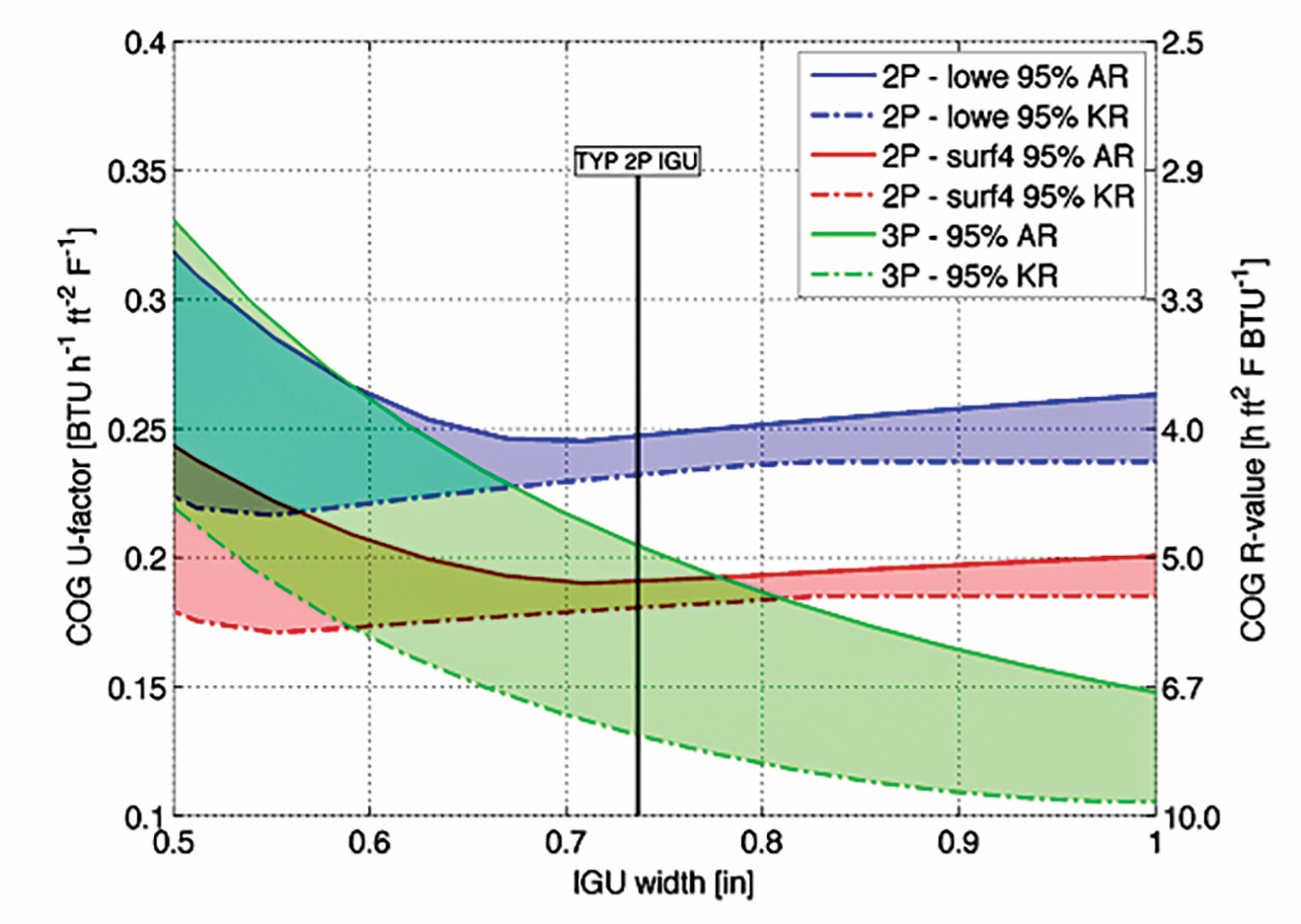
Figure 4. Thermal performance of double glazing (2P) compared to triple glazing (3P) windows at various insulating glass unit (IGU) thickness and filled with argon (AR) or krypton (KR). Blue represents most windows currently on the market. Red represents windows with an additional low-E coating on the inside surface, indicating modest performance gains. Green indicates significant potential energy savings with triple-glazed units. Credit: Lawrence Berkeley National Laboratory
One such technology is triple glazing, in which windows contain an additional layer of glass (or, alternatively, a membrane) to further improve insulation by providing two air spaces compared to one with double glazing (Figure 4). Triple glazing is not new, but previous iterations of these windows were bulky, heavy, and expensive.
However, a few key recent events in other markets have now converged to allow manufacturers to further refine tripling glazing technology, making these systems more compact and efficient. First, the rise of smartphones and flatscreen TVs expanded the production sizes and reduced the cost of fabricating large, thin panels of glass. Second, replacement of halogen lamps with LEDs dramatically reduced the demand and thus price of krypton gas, which is used to fill the air space in triple glazed units.26
Now, thin triple glazing units can be manufactured at more competitive prices with a 1-mm thin pane of glass in between a standard double-glazed unit, with krypton gas filling the now-divided air space (Figure 5).
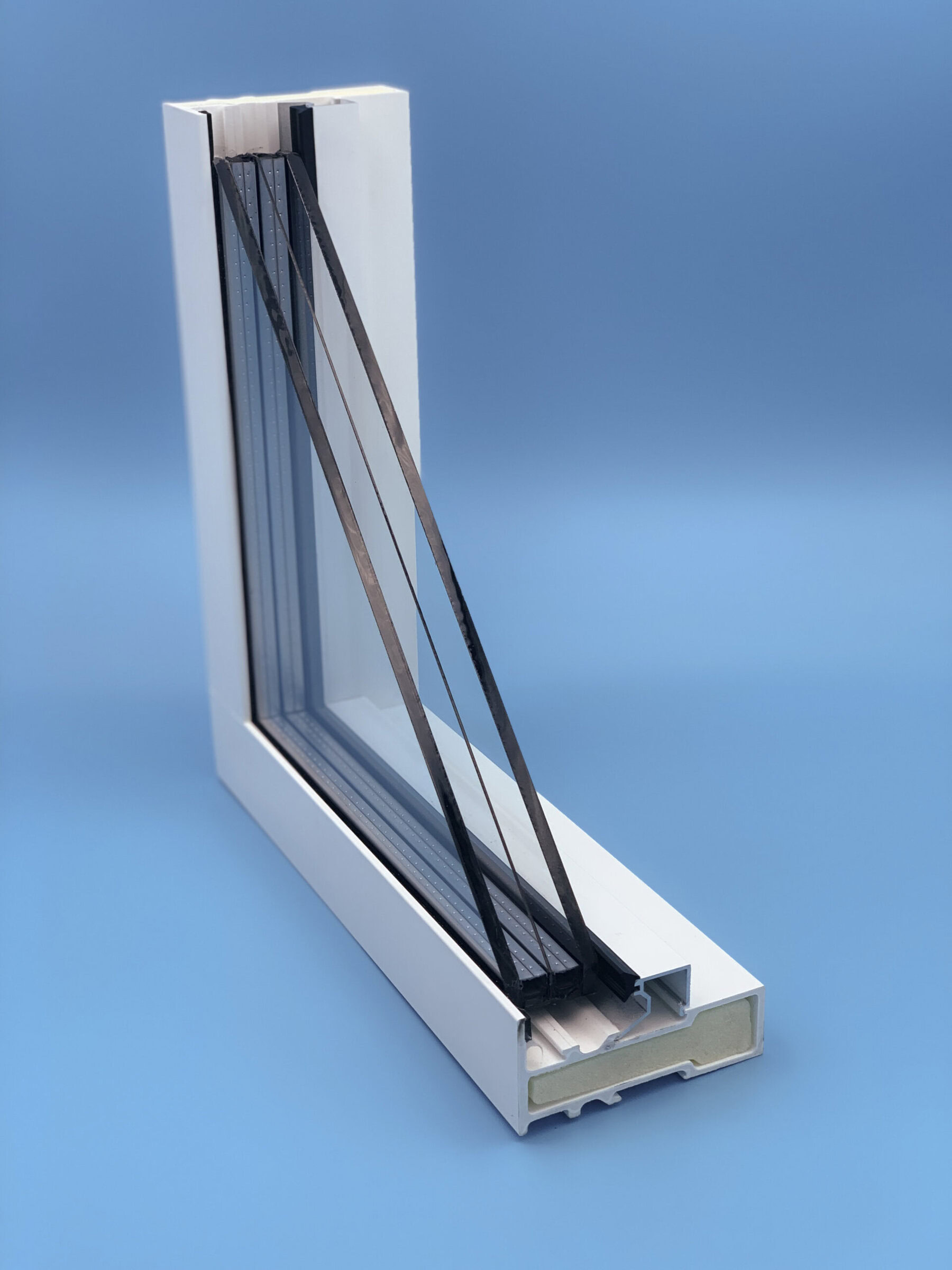
Figure 5. Cross-section of a triple-glazed window unit, showing a thin panel of glass that separates the standard air space in a double-glazed unit. Credit: Alpen
U.S. window manufacturers Alpen and Andersen are working with Berkeley Lab to develop these window technologies, and it seems these technologies may be coming to the market soon, although they are still more expensive than standard double glazing.
“We have spent some significant time investigating more automated lines capable of making thin-glass units,” Brad Begin, Alpen CEO, says in a Building Green article from early 2019.26 “I am actively working through a capital plan and in further discussions with potential capital sources to fund the plan.”
Another option to reduce thermal conduction and convection in windows is to nearly eliminate these parameters—by eliminating all air between the glass.
This idea is the concept behind vacuum glazing, a technology that, similar to triple glazing, has been around for decades. “But how we produce it, the sizes we produce it in, and the efficiency in production of materials are all changing,” Schimmelpenningh says.
With vacuum glazed units, however, the seal remains a challenge. “Because the vacuum between the glazing tends to pull the panes of glass together, tiny glass or ceramic spacers are also needed in a grid pattern to hold the glass apart—a technical and aesthetic complication,” according to a Building Green article.27
The spacing, materials, and design of these spacers are significant considerations beyond aesthetics, as these parameters impact the performance of the resulting window unit as well. However, if technological barriers can be removed, vacuum insulated glazing offers the ability to produce windows that are thin and low weight with much higher energy performance.
“New vacuum insulated glass from Guardian Glass (made in the U.S.) and VIG Technologies (made in China) are poised to make serious inroads into the high-performance glazing market in the US. They are not cheap, but if their long-term thermal performance can be verified, they may very well be worth the cost,” according to a recent Building Green article.28
Surfaces: Covered with choices
Floors, ceilings, walls—a house is filled with surfaces waiting to be covered. Many materials fulfill this purpose, from carpets, cement, tile, and wood on the floor to paint, paper, tile, and wood paneling on the walls.
In the late 1980s, U.S. Census Bureau data showed ceramic tile consumption at just over 1 billion ft2 per year.29 Thirty years later, consumption reached 3.11 billion ft2 in the U.S. in 2018.30 That growth reflects just a 1.5% increase over 2017 numbers, as figures for ceramic tile consumption over the past decade clearly demonstrate that the industry is still recovering from the recession.
In the future, demand for decorative tile is expected to increase 2.4% annually through 2023, with the fastest growth for porcelain tile due to its durability, performance, and aesthetics.31
Part of that slower growth can be attributed to a transformation in the resilient flooring market lately due to rising popularity of multilayer flooring, which includes new hybrid materials such as wood-plastic composite and solid polymer core (SPC) flooring.32 These alternative materials offer durability, comfort, low cost, and ease of installation.
“[SPC is] a very stable product—it’s warm to the touch and it’s much cheaper to install than ceramic tile, so it’s definitely cannibalizing ceramic tile sales,” says Paul Raiche, president and CEO of Ceratec, a ceramic tile manufacturing company (Quebec City, Canada). “Ceramic tile has to innovate because it’s moving around in the value chain right now.”
Part of that innovation is enabled by advancements in the equipment used to manufacture ceramic tiles, which has allowed tile sizes to get much bigger, Raiche says. Technological advancements in production lines allowed manufacturing of larger thin porcelain tiles, along with changes to improve the durability and reduce the weight of these larger formats.
As a testament of the growing popularity of larger format tiles, Italian porcelain tile company Iris Ceramica opened the first large-format thin porcelain tile panel production line in the U.S. in 2018 with its plant in Crossville, Tenn.
“This $70 million investment enhanced the production capacity of the company’s sole U.S. tile manufacturing plant by 20%, adding manufacturing capabilities for 120” × 60” panels, as well as large-format panels with 6-mm thicknesses,” according to a Freedonia article.33
The ceramic tile market still has a firm grip on walls, Raiche says. “What is not necessarily changing is feature wall products and backsplashes. What goes on the wall has become more important, as small shapes, geometric shapes, and very decorative materials coming out of ceramic tile factories are being used for walls.”
Innovation in thin glazes to create new finishes and textures allowed tile manufactures to create looks such as wood grains at the kiln, offering the ability to produce tiles in more shapes, sizes, textures, patterns, and finishes than ever before.
Essential sanitaryware
In the U.S., demand for all plumbing fixtures (which includes bathtubs, showers, sinks, toilets, hot tubs, spas, bidets, and drinking fountains) is expected to grow at a 5.0% CAGR through 2021 to reach an estimated market size of $7.6 billion.34
While these fixtures are now available in a variety of materials, ceramics still dominate many of the markets. For certain ceramic materials, sanitaryware accounts for a significant proportion of their end-use applications—for example, sanitaryware consumes 15% of ball clay use.35 Sanitaryware includes vitreous china (which leads the market), traditional fireclay, and fine fireclay.
“The fine fireclay is more popular in Europe because it gives you the opportunity to have really large formats, big dimensions,” says Felipe Mejia, ceramic engineer manager at Mansfield Plumbing Products. “The fine fireclay offers lower shrinkage rate and more dimensional stability, but it’s also harder to make or to produce [compared to traditional porcelain or washbasins],” which drives up the cost.
While various ceramics are used in washbasins (Figure 6), porcelain continues to be the preferred option for toilets. “It is a relatively cheap material, reliable, it lasts for many years, it doesn’t break easy unless you let something drop on top of it,” Mejia says.
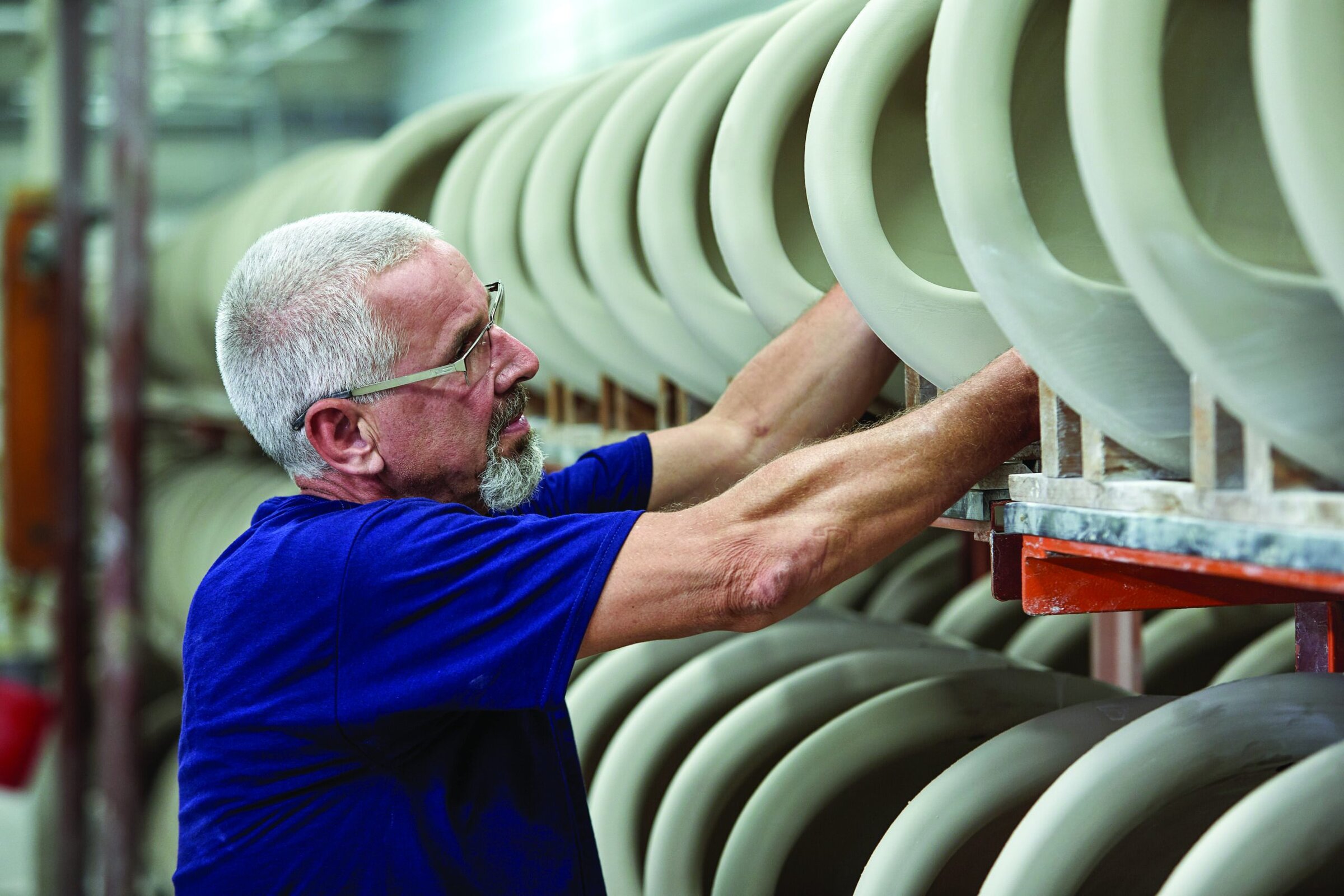
Figure 6. A worker at Mansfield Plumbing loads a batch of slip cast washbasins on the transportation cart. Ceramic engineer manager Felipe Mejia says the sanitaryware industry is looking to automate the more labor-intensive steps of the manufacturing process. Credit: Mansfield Plumbing
The manufacturing process for toilets has remained relatively unchanged over the years. Innovations instead have focused on toilet functionalities, such as water consumption. “There is a trend always to go toward a lower consumption of water every time you flush,” Mejia says. “Old toilets can use two, three, four times more water than the current toilets that we have on the market. So you can save the environment but at the same time you can save some money if you remodel and switch to the newest versions of the toilet.”
Other innovations in toilet technology include coatings that make the bowl easier to clean and more stain resistant. For example, Lixil (Tokyo, Japan) engineered a super-hydrophilic ceramic surface, called AquaCeramic, that uses water to lift oils and substances off the surface (Figure 7).
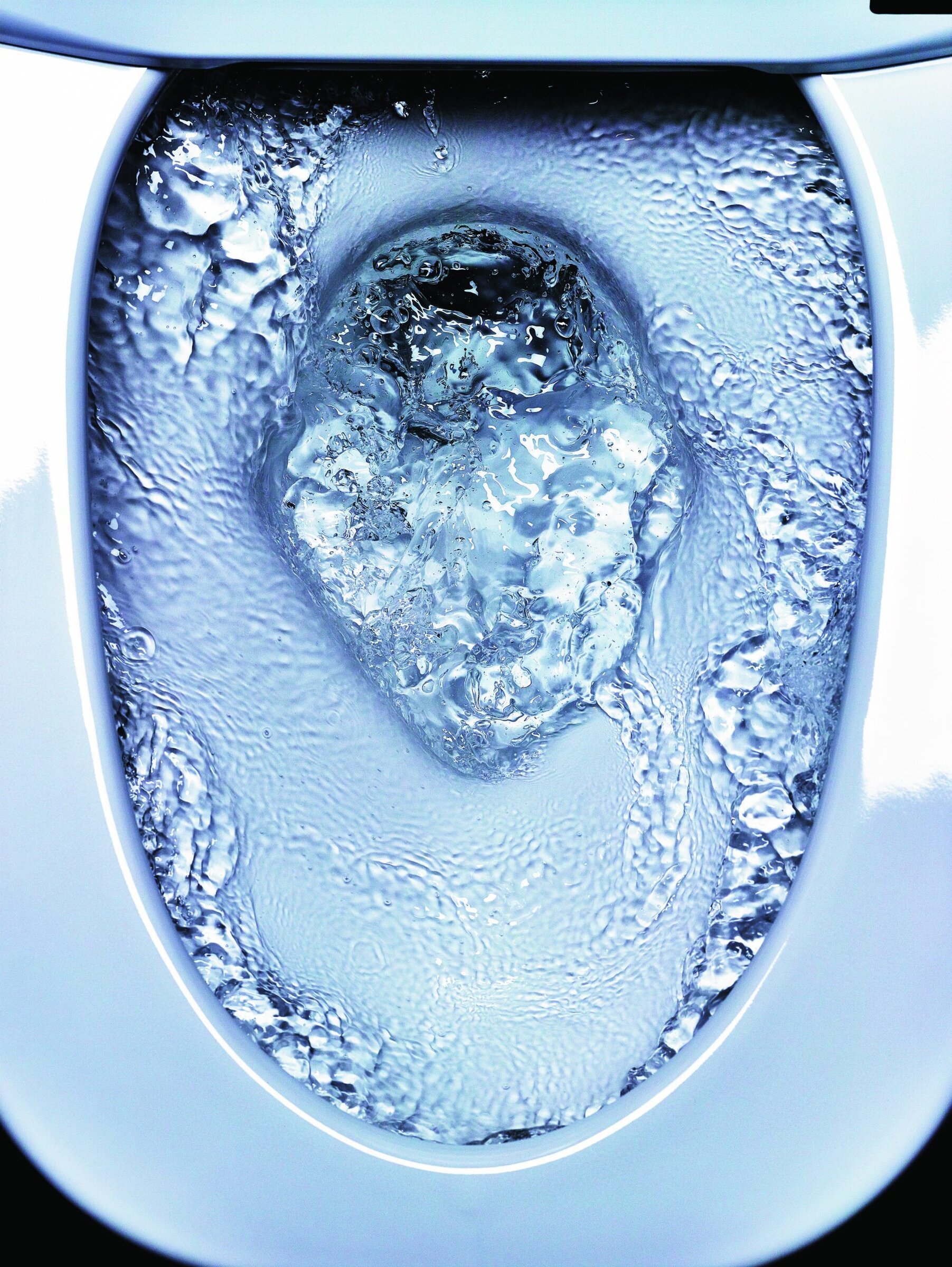
Figure 7. Lixil’s Aquaceramic super-hydrophilic ceramic is engineered to use water to lift oils and substances off the surface, offering the ability to wash away potential stains with a flush. Credit: Lixil
According a Lixil article,36 “The more problematic issue of hard water stains, which are caused by silica in the rinse water chemically combining with hydroxyl groups on the surface of the ceramic, has also been solved. AquaCeramic reinvents toilet materials by using a structure that does not expose hydroxyl groups, meaning that hard water stains are unable to build up and the ceramic surface remains flat and smooth.”
Although the company is not willing to share additional details about the AquaCeramic formulation or process, a Lixil press release indicates the company also developed a new glazing technique for the finish that “integrates a special substance to resist waste and hard-water stains at the molecular level,” which it says makes the finish last for 100 years.37 Watch a video of AquaCeramic in action at youtu.be/D9MSr-nfGQM.
Now we are cooking
Not many materials can claim they provide a sanitary, corrosion-resistant, easy-to-clean, extremely durable, heat-resistant, color-stable, and environmentally friendly finish—yet porcelain enamel can. Perhaps that is why it once coated entire homes (see Figure 8).
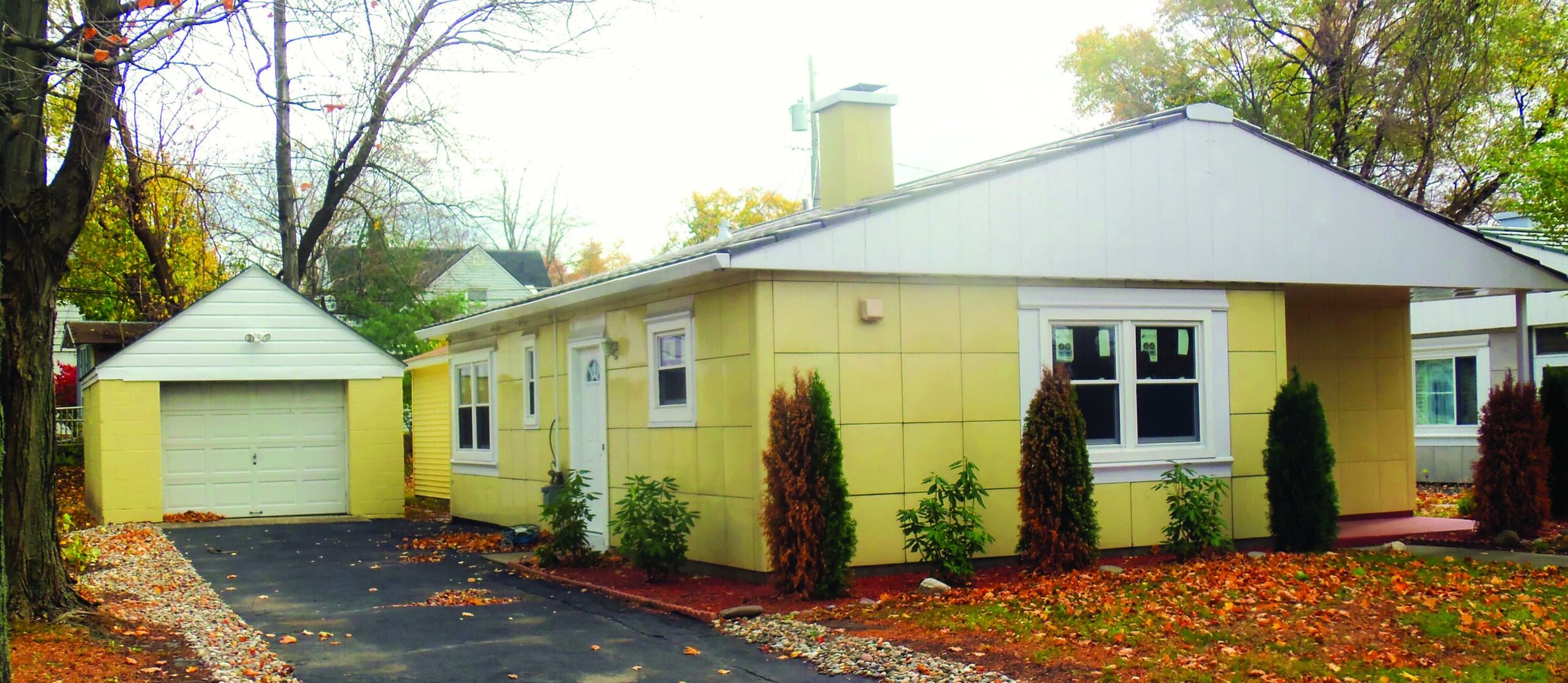
Figure 8. A porcelain enamel Lustron house still stands in Albany, N.Y. From 1948–1950, the Lustron Corporation used an assembly line in a former warplane manufacturing factory in Columbus, Ohio, to manufacture porcelain enamel houses as a quick and low-cost solution to the post-World War II housing crisis. Credit: Daniel Case; Wikimedia CC-SA 3.0
Porcelain enamel is primarily limited in modern kitchen appliances to the oven and stove, where it can be found on the top surfaces of burner cooktops, inside the oven cavity and door, and under the cooktop. Porcelain enamel covers cookware too, with an inert, antimicrobial, and long-lasting finish. Porcelain enamel’s durable finish also can still be found on the tops and spinner baskets of some laundry appliances as well as hot water tank liners.
Plastic has replaced porcelain enamel in many appliances because it is quicker, easier, and cheaper to manufacture. “You can injection mold an entire dishwasher cavity, which takes minutes, and it’s done. You don’t have to coat it, and you don’t need any particular labor input to fabricate it—it’s just a cheaper way to go,” says Cullen Hackler, executive vice president of the Porcelain Enamel Institute (Norcross, Ga.).
Color is an important consideration in the porcelain enamel industry. Higher-end appliance models often use porcelain enamel finishes to provide color on the exterior of units, although more affordable units today are likely painted or plastic instead. “One of the biggest drivers in the market is demand for new and different colors to make a product stand out,” says Charles Baldwin, R&D manager of porcelain enamels at Ferro Corp. (Cleveland, Ohio).
Because of those reasons, applications for porcelain enamel in modern homes are growing and can be increasingly found as finishes on grills, woodburning stoves, and outdoor fireplaces.
Porcelain enamel can be found in the bathroom as well, as a finish for plumbingware such as sinks, bathtubs, and shower trays. Plumbingware actually comprises the largest market for porcelain enamel today, followed by storage water heaters, and then major appliances, Hackler says. That order is reversed from 20 years ago.
In addition to competition from other materials, a significant current challenge for the porcelain enamel industry, perhaps surprisingly, is batteries.
Surging demand for lithium-ion batteries to power the modern world created significant supply and demand imbalances for raw materials lithium and cobalt—materials also important in porcelain enamel manufacturing—resulting in inflated market prices.
“Lithium in porcelain enamel is the most effective glass modifier flux for lowering the melting point of enamel while maintaining a dense glass structure that provides high corrosion resistance and high electrical resistivity for electrostatic application,” Baldwin says.
But replacing these raw materials in porcelain enamel is not a matter of simply swapping a new material in, Baldwin explains. “Other changes need to be made to glass formers and glass modifiers to obtain enamel with similar properties.”
The porcelain enamel industry continues to innovate with new formulations, however. Baldwin says one of the trends Ferro sees is the emergence of alternatives to self-cleaning pyrolytic ovens, once a great selling feature for these appliances. Eliminating the high heat and fumes associated with these cycles is both an energy and health consideration, so more appliances are turning to steam and water cleaning cycles instead.
Ferro’s hydrophilic AquaRealEase enamel product provides new functionality for such appliances. “In a low-temperature oven lined with AquaRealEase, tough soils like baked-on strawberry pie spills wipe clean with a damp cloth after soaking or exposure to steam from water heated at just 190°F for one hour,” according to a Ferro press release.38
When it comes to cleaning cooktops, however, nothing beats a smooth or flat cooktop. Often referred to as glass cooktops, that material is actually a glass-ceramic.
“One of the very interesting things about glass-ceramic that makes it a unique material compared to glass or other materials is its near-zero coefficient of thermal expansion,” Karen Elder, product manager of glass-ceramics at Schott North America (Louisville, Ky.), explains. That means it does not react to rapid changes in temperature or large temperature differentials without shattering, warping, or deforming, making it ideal for applications such as cooktops and fireplaces.
One big innovation in glass-ceramic cooktops is induction cooktops, Elder says, which are currently much more popular in Europe than in the U.S. Induction cooktops do not use radiant heating elements to generate thermal energy but rather use an electromagnetic field to induce currents, which heat pots made of metals such as stainless steel and cast iron. Induction cooking generates far less waste heat than radiant heating elements, making it a much more energy efficient process.
However, the lack of traditional heating elements comes with a caveat—because there is no open flame or red-hot heating element, it can be difficult to visually determine if the induction cooktop burner is on.
One solution is to incorporate lights into induction cooktops. “We’re moving into new formulations that allow different colors of light to come through the cooktop, which opens up design opportunities for our customers to integrate things like white light,” Elder says.
Schott’s glass-ceramic provides better light transmission through the material so that lights can be integrated underneath the cooktop—when the lights are off, the cooktop appears uniformly monochromatic; when on, the lights provide a visual cue that a burner is active (Figure 9).
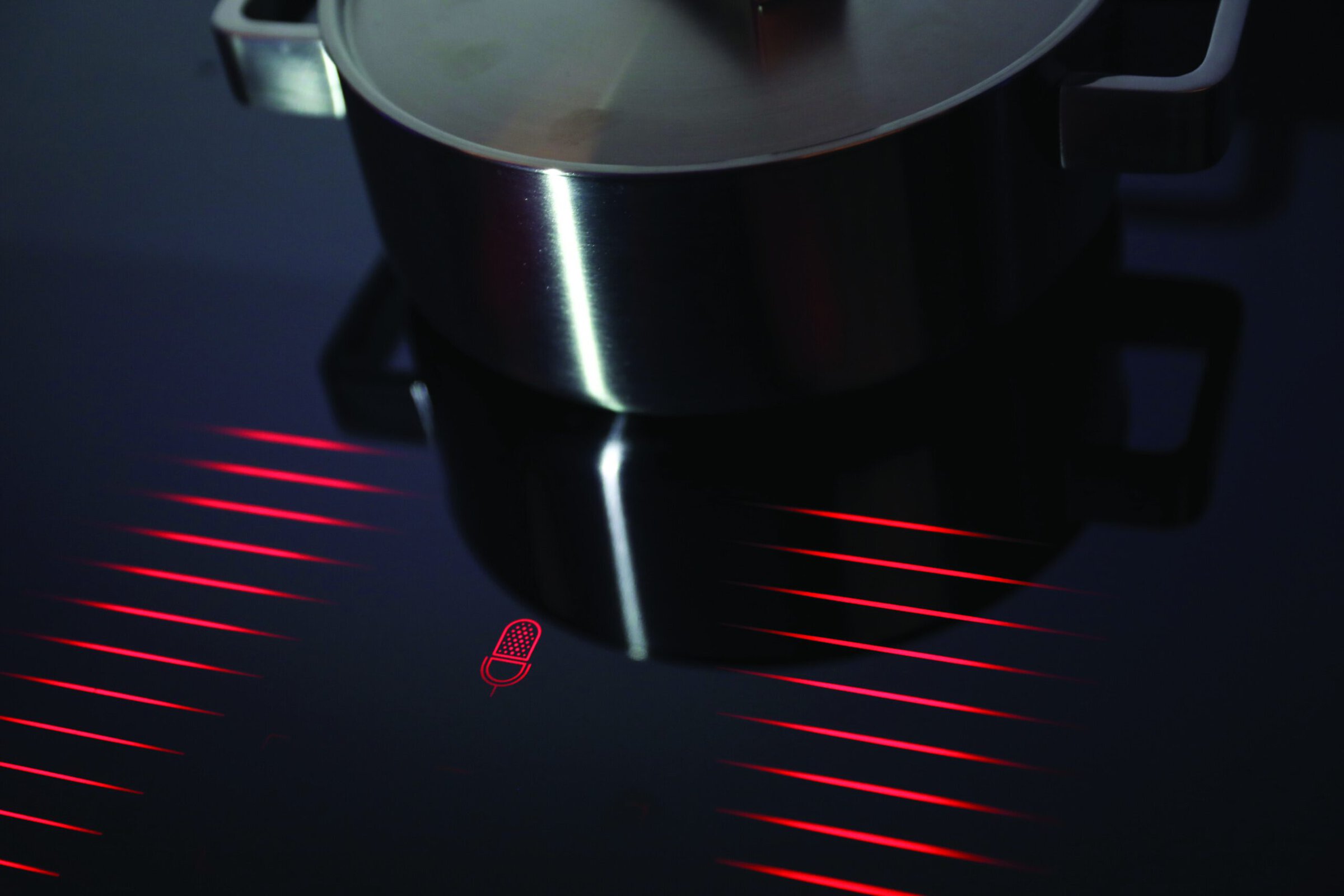
Figure 9. Schott’s glass-ceramic cooktop can incorporate lights underneath the cooktop, opening up interesting new possibilities for technology in the kitchen. Credit: Schott North America
Plus, the lack of heating elements in induction cooktops also opens up new abilities to integrate additional electronics, such as liquid-crystal displays, into cooktops to further bring technology into the kitchen.
Other uses for glass-ceramic include innovations such as grills and toasters equipped with clear glass-ceramic windows. “We are always tweaking [the glass-ceramic] recipe and seeing what we can do to enhance it,” Elder says.
What will the homes of tomorrow look like?
Future home
“If you look at current trends, I think you’re going to see smaller homes where you have multifunctional materials, and therefore you don’t need big spaces,” says Eastman Chemical’s Julia Schimmelpenningh. “But those materials are going to have to do more, they’re going to continue to evolve to be multifunctional.”
One of the ways that materials are doing more is through integration of technology. Technology allow us to connect with our homes through the Internet of Things (IoT) and smart technologies in unprecedented ways, allowing integration and crosstalk across diverse platforms.
“The kitchen is one of the places where there’s so much activity happening in the house, and it’s definitely where there’s a gap—there can be more efficient ways to use that time in the kitchen,” says Schott’s Karen Elder.
Innovations in materials such as transparent glass-ceramic options for cooktops are enabling these advances by integrating displays into cooking surfaces, for example, and providing connected multimedia experiences such as the ability to interact with a recipe while actively cooking. These advancements further blur the lines of technology within the home by integrating them ever more seamlessly.
In addition to connecting us to our homes, technology brings improved energy efficiency in buildings. By incorporating sensors, actuators, and microchips to automate processes such as heating and cooling, ventilation, lighting, and security, smart homes offer additional opportunities for houses to improve energy efficiency. “With companies such as Hitachi, IBM, Cisco investing in this technology, the demand for the smart buildings is expected to rise and generate a global revenue of $8.5 billion by 2020,” according to the BCC report.3
Future homes will continue adapting to the changing environment as well, especially as severe weather patterns continue to challenge a warming world. “Materials will continue to evolve to be increasingly impact resistant to endure stronger and more frequent storms,” says Saint-Gobain’s Lucas Hamilton.
For example, laminated glazing dramatically increased the safety of building glass especially in hurricane-prone areas, allowing the material to more effectively protect against windborne debris.
In many cases, ceramic and glass materials already offer superior solutions over alternative building materials. For example, brick is one of the strongest exterior cladding materials available for homes.
NBRC’s tests with walls built from various exterior cladding materials show that, when faced with a 9-lb wooden 2×4 “missile” traveling at about 50 mph, brick is the only material that can withstand the abuse.
“When we hit a typical particle board wall, it goes through the wall. When we hit vinyl siding, it goes through the wall. When we hit EFIS [exterior insulation finishing system, a stucco-like finish], it goes through the wall,” says Sanders, director of NBRC. “When we hit brick, we tend to destroy the missile.” A video of NBRC’s test is available at youtu.be/fDk0QKEc02Q.
Brick also boasts excellent thermal performance as well, which is an important consideration in some parts of the U.S. in light of growing frequency of devastating wildfires. “Having that ceramic material on the outside of your house could buy you extra time,” Sanders adds.
Entire homes constructed out of concrete offer a still more extreme solution to protect inhabitants from severe environmental conditions, including fire and debris.39
Ultimately, these diverse evolutions in the construction industry and more broadly in the world may point to serious changes ahead for many building products—but they also represent significant opportunities.
“As the complexity of these systems increases, so does the methodology, the science, the innovation—all that is able to come into these systems more and more,” Schimmelpenningh says. “So the opportunities for innovation increase with the complexity.”
That is good news for the materials that make these building products, as innovation is something the materials do exceedingly well. As preferences continue to demand products that do more, materials will rise to the challenge—pushing for higher performance, becoming more multifunctional, and improving in many other ways.
Ceramic and glass materials have been and will continue to be a significant part of this equation because they provide a unique combination of durability, reliability, performance, and beauty to the structures we inhabit.
“The combination of safety, lifespan, and thermal performance, when you look at the whole, makes ceramic materials really a no brainer,” says Sanders. “They are so far superior to everything else.”
Read more: “Functional pottery in the home“
Read more: “Rooms with a view—Dynamic window glazing“
Cite this article
A. Gocha and L. McDonald, “Right at home—How ceramics and glass contribute to the $4.17T residential building market,” Am. Ceram. Soc. Bull. 2019, 98(9): 16–29.
Issue
Category
- Cements
- Glass and optical materials
- Structural clay products
Article References
1United Nations Environment and International Energy Agency, “Towards a zero-emission, efficient, and resilient buildings and construction sector: Global Status Report 2017.” https://www.worldgbc.org/sites/default/files/UNEP%20188_GABC_en%20%28web%29.pdf
2World Economic Forum, “Shaping the Future of Construction: A Breakthrough in Mindset and Technology,” May 2016. http://www3.weforum.org/docs/WEF_Shaping_the_Future_of_Construction_full_report__.pdf
3BCC, “Residential Building Construction Industry: Global Markets to 2022” (Report Code: MFG045A), March 2018.
4National Association of Home Builders, “Housing’s Contribution to Gross Domestic Product (GDP).” https://www.nahb.org/research/housing-economics/housings-economic-impact/housings-contribution-to-gross-domestic-product-gdp.aspx
5P. Emrath, National Association of Home Builders, “Impact of Home Building and Remodeling on the U.S. Economy,” May 1, 2014. https://www.nahb.org/research/housing-economics/housings-economic-impact/impact-of-home-building-and-remodeling-on-us-economy.aspx
6National Association of Home Builders, “The Economic Impact of Home Building in a Typical State: Income, Jobs, and Taxes Generated,” April 2015.
7R. DiNola, “2019 is the year of energy codes,” New Buildings Institute, January 14, 2019. https://newbuildings.org/2019-is-the-year-of-energy-codes
8J. Snook, “How Does Construction Impact the Environment?,” Go Contractor, June 21, 2017. https://gocontractor.com/blog/how-does-construction-impact-the-environment
9U.S. Census Bureau, “Highlights of Annual 2018 Characteristics of New Housing.” https://www.census.gov/construction/chars/highlights.html
10Demographia, “International house sizes.” http://demographia.com/db-intlhouse.htm
11Freedonia Group, “Global Roofing Sales to Reach $120 Billion in 2022,” March 26, 2019. https://www.freedoniagroup.com/Content/News/2019/03/26/Global-Roofing-Sales-to-Reach-120-Billion-in-2022
12M. Zielenski, Freedonia Group, “3 Key Opportunities for US Residential Roofing Producers in 2019 & Beyond,” February 7, 2019. https://www.freedoniagroup.com/Content/Blog/2019/02/07/3-Key-Opportunities-for-US-Residential-Roofing-Producers-in-2019–Beyond
13C. Corridoni, “Cool Roof Basics and Benefits (Infographic),” CertainTeed, September 6, 2016. https://blog.certainteed.com/2016/09/its-not-getting-hot-in-here/?_ga=2.109758021.178116390.1571491957-962275374.1571491957
14IBISWorld, “Clay Brick & Product Manufacturing Industry in the US,” May 2019. https://www.ibisworld.com/united-states/market-research-reports/clay-brick-product-manufacturing-industry
15U.S. Census Bureau, “Annual Characteristics of New Housing,” 2018. https://www.census.gov/construction/chars
16Freedonia Group, “Fiber Cement Siding (Cladding) to Show Fastest Global Growth Through 2022,” February 14, 2019. https://www.freedoniagroup.com/Content/News/2019/02/14/Fiber-Cement-Siding-Cladding-to-Show-Fastest-Global-Growth-Through-2022-
17E. De Cian, F. Pavanello, T. Randazzo, M.N. Mistry, M. Davide, “Households’ adaptation in a warming climate. Air conditioning and thermal insulation choices,” Environ. Sci. Policy, 100, 136–157 (2019).
18American Chemistry Council “The Contributions of Insulation to the U.S. Economy in 2017,” April 2018. https://polyurethane.americanchemistry.com/The-Contributions-of-Insulation-to-the-US-Economy-in-2016.pdf
19J. Levy, M.K. Woo, S.L. Penn, M. Omary, Y. Tambouret, C.S. Kim, S. Arunachalam, “Carbon reductions and health co-benefits from US residential energy efficiency measures,” Environ. Res. Lett., 11 (2016).
20Freedonia Group, “Insulation in the US by Material, Market and Region, 12th Edition,” December 2017. https://www.freedoniagroup.com/industry-study/insulation-in-the-us-by-material-market-and-region-12th-edition-3597.htm
21Home Innovation Research Labs, “Insulation Choices Revealed in New Study,” June 19, 2019. https://www.homeinnovation.com/trends_and_reports/trends/insulation_choices_revealed_in_new_study
22U.S. Department of Energy, “Insulation.” https://www.energy.gov/energysaver/weatherize/insulation/insulation-materials
23North American Insulation Manufacturers Association, “Survey shows manufacturers used 2.2 billion pounds of recycled materials in the production of fiber glass and slag wood insulation,” July 18, 2019. https://insulationinstitute.org/wp-content/uploads/2019/07/Survey-Shows-Manufacturers-Used-2.2-Billion-Pounds-of-Recycled-Content-in-2018.pdf
24Family Handyman, “Mineral Stone Wool Insulation is Making a Comeback. Here’s Why.” https://www.familyhandyman.com/walls/mineral-wool-insulation-is-making-a-comeback-heres-why
25Lawrence Berkeley National Laboratory, “Triple Glazing with Thin Non-Structural Center Glass.” https://windows.lbl.gov/triple-glazing-thin-non-structural-center-glass
26P. Yost, “Thin Glass to Change High-Performance Window Market,” Building Green, February 4, 2019. https://www.buildinggreen.com/product-review/thin-glass-change-high-performance-window-market
27T. Roberts, A. Wilson, “Choosing Windows: Looking Through the Options,” Building Green, January 27, 2011. https://www.buildinggreen.com/feature/choosing-windows-looking-through-options
28P. Yost, “R-10 Vacuum-Insulated Glazing: For real this time?, ”Building Green, October 22, 2018. https://www.buildinggreen.com/blog/r-10-vacuum-insulated-glazing
29C.W. Verity, C.J. Brown, B. Smart, C.E. Cobb Jr., “1988 U.S. Industrial Outlook with expanded coverage of the services sector, construction, high-tech, and emerging industries,” U.S. Department of Commerce, pg. 2.15, 1988. Retrieved from https://books.google.fr/books?id=R4AARGVH83UC&
30M. Garside, “Ceramic tile consumption in the United States from 2009 to 2018 (in thousand square feet),” Statista, 2019. Retrieved from https://www.statista.com/statistics/325877/ceramic-tile-total-consumption-in-the-us/
31Freedonia Group, “US Decorative Tile Demand for Flooring to Increase 2.3% Annually Through 2023,” April 10, 2019. https://www.freedoniagroup.com/Content/News/2019/04/10/US-Decorative-Tile-Demand-for-Flooring-to-Increase-23-Annually-Through-2023-
32Freedonia Industry Studies, “Multilayer Flooring, a New Subcategory: Taking the Resilient Market to the Next Level,” February 26, 2019. https://www.freedoniagroup.com/Content/Blog/2019/02/26/Multilayer-Flooring-a-New-Subcategory-Taking-the-Resilient-Market-to-the-Next-Level
33N. Cunningham, “Italy’s Iris Ceramica Bets Big on Thin, Large-Format Porcelain Tile in the US,” May 21, 2019. https://www.freedoniagroup.com/Content/Blog/2019/05/21/Italy’s-Iris-Ceramica-Bets-Big-on-Thin-Large-Format-Porcelain-Tile-in-the-US
34Freedonia Group, “Plumbing Fixtures Market in the US – Demand and Sales Forecasts, Market Share, Market Size, Market Leaders (Study #: 3545)” June 2017. https://www.freedoniagroup.com/Plumbing-Fixtures.html
35U.S. Geological Survey, “Mineral Commodity Summaries 2019.” https://www.usgs.gov/centers/nmic/mineral-commodity-summaries
36Lixil, “LIXIL’s AQUA CERAMIC makes bathroom stains a thing of the past,” October 21, 2016. https://www.lixil.com/en/stories/stories_06
37Lixil, “LIXIL Develops New Stain-Resistant Ceramic Technology That Promises a Clean Toilet that Lasts a Century,” February 24, 2016. https://www.lixil.com/en/news/pdf/20160224_AQUA_CERAMIC.pdf
38Ferro Corp, “Ferro Launches Two Porcelain Enamel Coatings at International Home & Housewares Show,” March 13, 2007. https://www.businesswire.com/news/home/20070313005823/en/Ferro-Launches-Porcelain-Enamel-Coatings-International-Home
39Portland Cement Association, “Concrete Homes: Built-in Safety.” https://www.cement.org/cement-concrete-applications/paving/buildings-structures/concrete-homes/technology-briefs/concrete-homes-built-in-safety
Related Articles
Market Insights
Lessons learned from the rollout of 5G technology help guide 6G preparations
While it may seem like the 5G communications and data network has just been rolled out—and is, in fact, still in the process of being deployed—communications providers, governments, and researchers are already preparing for the sixth generation of wireless technology, or 6G. Compared to 5G, which aimed to expand the…
Bulletin Features
The synthetic data revolution: How AI is redefining quality control in ceramics manufacturing
The ceramics industry stands at the brink of a fundamental shift in how quality control is conceived, implemented, and scaled. For decades, the promise of artificial intelligence-powered inspection systems was held back by a persistent obstacle: the scarcity of high-quality data. This bottleneck made it difficult for ceramics manufacturers to…
Market Insights
Global edge AI market
The global market for edge artificial intelligence was valued at $8.7 billion in 2024 and is expected to grow at a compound annual growth rate (CAGR) of 36.9% to reach $56.8 billion by the end of 2030. Edge computing refers to data processing that occurs closer to where the data…
